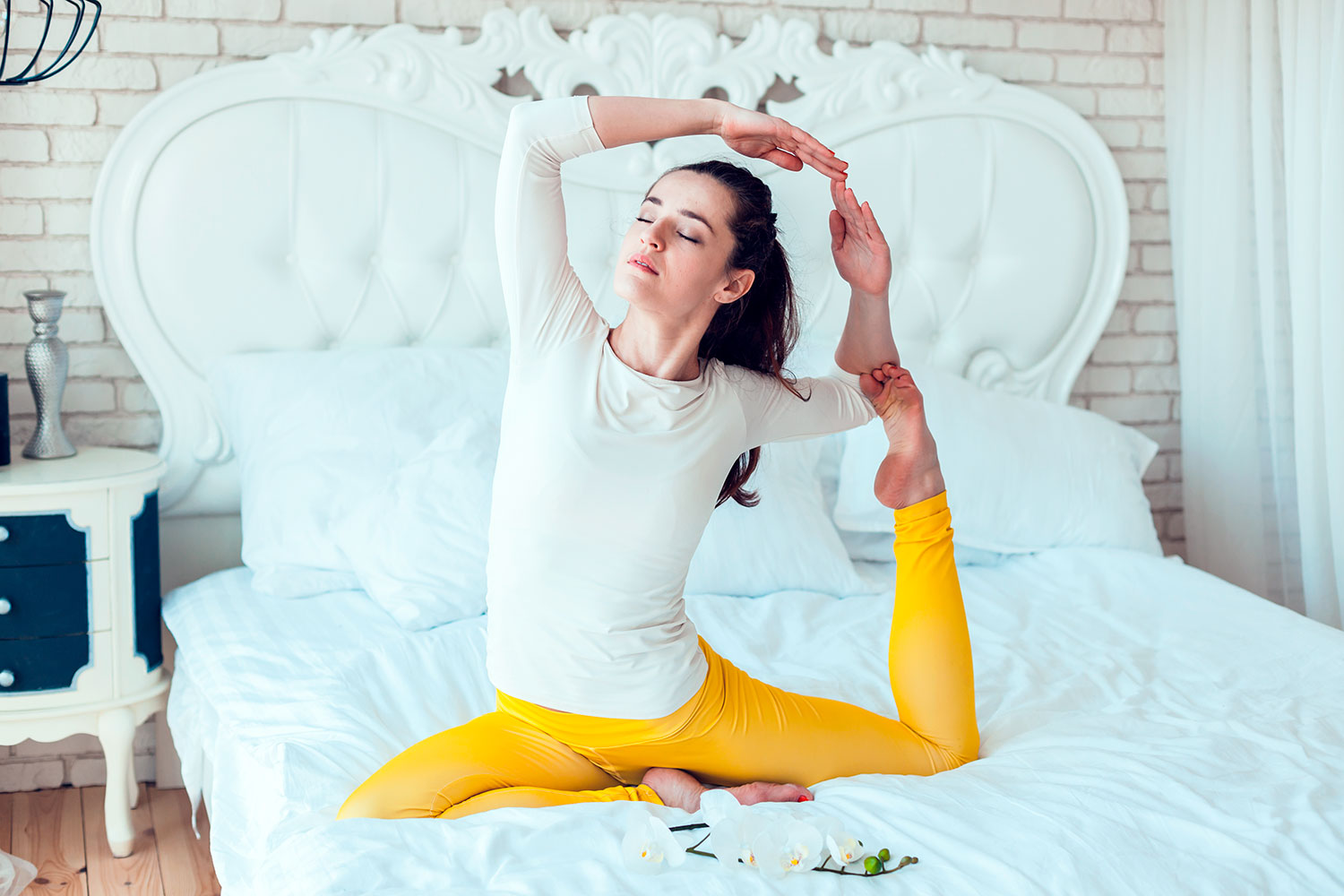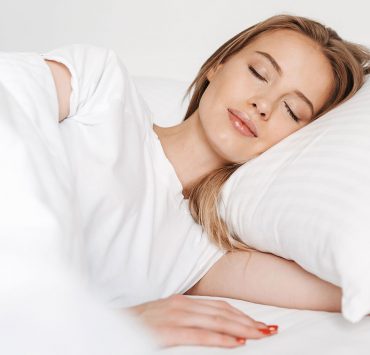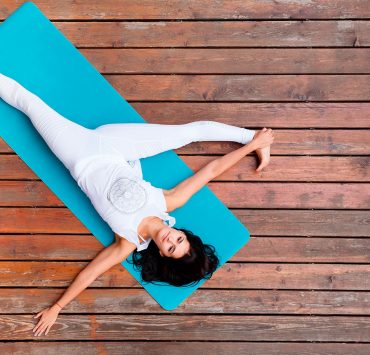
Having been a teacher’s assistant at over 50 yoga teacher…
Sleeping problems can be attributed to several physical or psychological stressors: stress, anxiety, or a restless mind account for more than 50% of the roots of insomnia, while muscle tension, pain, discomfort, or poor sleep hygiene account for nearly 70% of reported cases of sleep disturbances.
While the reasons for restless sleep are numerous, “restorative yoga” can be used to improve sleep quality.
Restorative Yoga for Improved Sleep
Restorative yoga is a type of yoga that focuses on passive stretching and meditation to unwind: slowing the mind and body to promote improved blood flow, muscle relaxation, and to calm the nervous system – all which can promote deep, restful sleep. Restorative poses are usually held for 5 minutes at a time or more, which allows for the body to achieve relaxation. Most of these poses are based on the teachings of B.K.S. Iyengar.
Restorative poses usually encourage the use of props – pillows, blocks, or walls – to assist in achieving full relaxation and rest. Restorative yoga uses gentle twists, seated forward folds, gentle backbends, and heart openers to calm the nervous system. Pair these with meditation and breathing exercises to allow the body to relax into the postures and quiet the mind before bed.
Create a Sleep Routine

Research by the National Sleep Foundation found that “sleep hygiene” is an important contributor to a good night’s rest. Sleep hygiene refers to practices and habits before bed to reduce stimulation and improve deep sleep, such as: keeping a space quiet, dimly lit, and with minimal electronics right before bed.
To get the full benefits of restorative yoga at bedtime, cultivate a relaxing evening routine: a nightly ritual of 10-15 minutes to unwind. This should include a restorative practice with meditation.
Create an environment that promotes deep sleep: avoid electronics before bed (avoid electronics in the bedroom if possible, otherwise, experts recommend turning off electronics 90 minutes before it’s time to sleep), keep the bedroom quiet, and turn down the lights. By limiting external stimulation, this signals to your body that it is time to unwind and prepare for rest.
Practice slow breathing exercises or meditation before bed, paired with these eight poses for improved sleep. These can be done on a mat on the floor or on the bed. Hold each of these poses for 3-5 minutes, allowing your body to relax fully into them.
Balasana — Child’s Pose

How it works to promote sleep: This is a true resting pose that promotes relaxation and calmness, while relieving tension in the back, shoulders, neck, and hips.
The pose: Sit up comfortably on your heels, then roll your torso forward, bringing your head to rest on the floor or a pillow in front of you. Lower your chest to the floor, focusing on stretching your arms and feeling the weight of your shoulders relax. Hold the pose for 3-5 minutes, focusing on deep breaths and softness.
Uttanasana — Forward Fold Pose

How it works to promote sleep: From a standing position, this pose allows gravity to do the “work” for you, stretching the spine, backside, and hamstrings, while calming the nervous system. The forward bend relaxes the spine while relieving stress and anxiety.
How to do it: You can do this pose either standing (standing forward fold) or seated (seated forward fold). From a standing position: start with your feet under your shoulders, grounded to the floor. Bend at the hips and move your torso down, bringing your hands toward your feet. Focus on letting your arms hang down toward the ground, letting gravity release tension in your back, spine, and shoulders.
Seated forward fold: Sit on your mat, with your spine stretched tall and your legs in front of you, heels pressed into the ground. Slowly bend forward from the hips, moving your torso toward your knees. Bring your hands to your ankles or feet, allowing your head to hang down. Breathe deeply. Keep a slight bend in your knees if you feel pain in the lower back.
Marjaryasana — Cat/Cow Poses

How it works to promote sleep: Together, these two poses relieve tension in the spine, shoulders, and low back. They also stretch the back and open the chest, encouraging a deep breath and mental relaxation.
How to do it: Start on your hands and knees, with your wrists directly under your shoulders, knees are under your hips, and your legs hips’-width apart. Begin by moving into Cow Pose: inhale as you drop your belly toward your mat, lifting your head and chest, and gazing up to the ceiling. Try not to pinch your back, but let it stretch as you drop your belly toward the floor.
Then, exhale as you draw your belly to your spine, rounding your back toward the ceiling. Think of a cat stretching its back: rounding the upper back, and releasing the crown of your head toward the floor. Inhale as you move back into Cow pose, and repeat this sequence 5-20 times.
Upavistha Konasana — Seated Wide-Angle Forward Fold Pose

How it works to promote sleep: Hips hold stress and tension. By focusing on stretching the hips, hamstrings, groin, and lower back, this releases tension and promotes relaxation. The forward folding posture is calming and restorative, relieving anxiety and preparing the mind for sleep.
How to do it: Begin in Staff Pose (Dandasana), with your legs in front of you and your spine straight. Use your hands to support your torso as you spread your legs as wide apart as possible. Ground your thighs to the floor and keep your knees pointing up toward the ceiling. Walk your hands forward between your legs, keeping your spine long and forearms supporting your body. As your body relaxes, continue stretching forward when possible.
Viparita Karani — Legs Up the Wall Pose

How it works to promote sleep: This restorative pose is an essential stress reliever, and is a passive inversion that eases tension headaches, anxiety, and insomnia. When held for at least 5 minutes (10-15 is preferred), this pose gently stretches the lower back, torso, legs, and shoulders, while easing tired, achy feet. The mild inversion relieves anxiety and calms the mind before bed.
How to do it: For this pose, you will need a wall as your guide. Start in a seated position, 5-6 inches away from the wall. Swing your legs up onto the wall, with your shoulders and head resting on the floor. If possible, scoot your sit bones against the wall, so that your legs are in a 90-degree angle with your hips. (For tight hamstrings, keep your sit bones a few inches away from the wall, working closer as you gain flexibility.) Keep your chest long, and allow your feet to press into the wall. Keep your legs firm enough to hold them in place, but allow them to relax. Breathe deeply as gravity pulls the weight from your legs toward the floor. Hold for 5-15 minutes.
Eka Pada Rajakapotasana — One-Legged King Pigeon Pose

How it works to promote sleep: Like wide-angle forward bend, Pigeon Pose is used to relieve stress in the hips and lower back—two places that hold the bulk of stress and tension during the day. This hip-opener releases the hip flexors, psoas, and lower back, while the forward fold allows the shoulders, spine, and neck to relax. This pose is ideal for stress-relief and calming the mind before bed.
How to do it: Begin in Downward-Facing Dog (Adho Mukha Svanasana), then raise your right leg so it extends up away from you. Bring your right leg forward, with your knee toward the back of your right wrist. Your left leg should be flat on the floor behind you, and your right leg should be at a comfortable angle—knee on the inside of your right wrist. As you relax into this pose, keep your hips square, and gently fold forward, reaching your arms forward and palms against the mat. Hold for 3-5 minutes, then switch sides.
Uttana Shishosana — Extended Puppy Pose

How it works to promote sleep: This is a cross between Child’s Pose and Downward-Facing Dog, and it combines the benefits of both: a naturally restful position, Puppy Pose releases tension in the shoulders, upper back, neck, and back, while maintaining the benefits of Downward Facing Dog’s inversion. This lengthens the spine, releases tension in the shoulders, and calms the mind.
How to do it: Begin on all fours, with your wrists square under your shoulders and your knees underneath your hips. Exhale as you move your sit bones halfway back toward your heels. Keep your arms active, and don’t touch your elbows to the ground. Instead, drop your forehead to the floor and let your neck relax, as you feel a long stretch in your spine and upper shoulders.
Savasana — Corpse Pose

How it works to promote sleep: This pose is often used to conclude yoga classes because it is both restorative and meditative. For this reason, it is ideal in a bedtime ritual for better sleep. Corpse pose lowers blood pressure and heart rate, stretches the limbs, and aligns the spine. This pose also alleviates muscle tension, promoting relaxation before bed.
How to do it: Lie on your back with your legs straight and arms out at your sides, palms facing up. Working from your toes up to the crown of your head, focus on releasing tension in every part of your body. Let your breath occur naturally as you let the weight of your body fall to the floor, consciously relaxing your legs, arms, chest, and face.
Bonus
Try these Vinyasa flows 10-30 minutes before bed. These are sequences designed to help calm the mind and relax for a restful night’s sleep:
1. 10-Minute Nighttime Yoga with Brett Larkin
2. 20-Minute Yoga for Bedtime with Adriene
3. Bedtime Yoga with Cole Chance
4. Yoga to Help You Sleep with Catalina Moraga
5. Bedtime Yoga to Calm Your Nerves with Tim Senesi
Summary
By establishing a nighttime routine of restorative yoga poses, both your mind and body can unwind to prepare for a deep, restful night’s sleep.
What's Your Reaction?
Having been a teacher’s assistant at over 50 yoga teacher trainings worldwide, Rebecca Rebecca has a firm grasp on the fine art of yoga and meditation. In her work, she carefully reflects on a vast expanse of knowledge to help others find peace in both body and mind.














